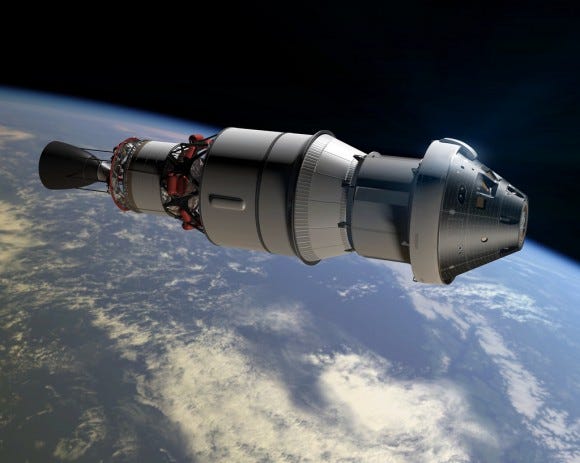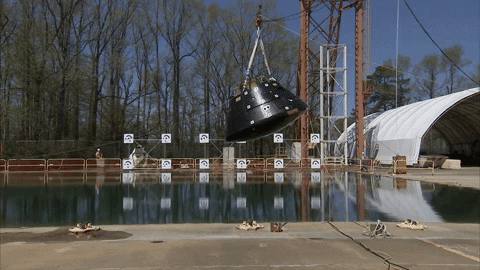Moon Monday Issue #22
NASA begins fueling Orion for its first Moon trip, hardware upgrades ongoing for safer crewed missions, enigmatic volcanic mounds on the Moon, and more developments in the lunar space.
Highlight
NASA has begun fueling the Orion spacecraft for the Artemis I uncrewed mission to fly around the Moon and come back to Earth. The engineers started filling its European-built service module with oxidizer last week, and will load the propellant next. Then the engineers will fuel Orion’s crew module, whose 12 thrusters control the capsule’s rotation after it’s separated from the service module. Once Orion is ready, the team will fuel the ULA-and-Boeing-built Interim Cryogenic Propulsion Stage (ICPS), which sits between the SLS rocket’s core stage and Orion, and will push Orion out of Earth orbit to the Moon. When fueling is complete in several weeks, Orion will have its launch abort system integrated while the ICPS will be prepared for stacking on top of the SLS core stage.

Meanwhile, the command, control and data processing system to be used at the mission control center during Artemis I launch has been certified and ready for the team to practice simulated launches with before the real deal. NASA is officially still sticking to a late 2021 launch for Artemis I but keen observers of the Artemis program consider H1 2022 to be more likely. NASA is expected to announce a formal revised launch date in a month or two now that the SLS rocket’s major hot fire test is complete and the core stage is being refurbished.
Related: It turns out Orion will be performing a skip atmospheric reentry, like Chang’e 5, when returning to Earth after Artemis missions––a first for a human spacecraft. In this maneuver, Orion, as it comes back from the Moon, will first enter Earth’s upper atmosphere and use that along with the capsule’s lift to ‘bounce’ before re-entering for final descent. This will allow Orion to more precisely touchdown in the ocean compared to Apollo while also allowing astronauts to experience lower g-forces by spreading one high acceleration event into two relatively lower ones.
Exploration
NASA successfully performed a second drop test of a mock version of the Orion capsule on April 6. According to Jacob Putnam, a data analyst for the tests, this drop of the capsule was from a height of about 2 meters whereas the next one will be a much higher one. The fourth and the last test will be a swing drop, thus adding a horizontal velocity component to simulate a realistic mission scenario. During all tests, data is collected from about 500 sensors––mostly strain gauges, accelerometers, and rotational rate sensors––to help engineers better understand and tweak what the crew will experience when the 6350-kilogram spacecraft lands in the Pacific Ocean after an Artemis Moon mission, starting with Artemis II.

Another development for Artemis II and beyond is that NASA is upgrading the water shower system to more evenly absorb the heat and energy from the SLS rocket launch to better protect ground systems, the rocket and its crew.
On April 9, the U.S. Biden administration released their space budget proposal for fiscal year 2022, part of a general 41-page budget document. It provides only high-level details, with a full proposal expected only in spring. The White House is proposing NASA’s budget to be approximately $24.7 billion, a 6.3% increase over the roughly $23.3 billion the agency received for the fiscal year of 2021. NASA’s human exploration program would get $6.9 billion, just 5% more than 2021’s $6.56 billion, suggesting that the administration doesn’t plan to increase spending on the Human Landing System program as the Trump administration originally envisioned when setting a 2024 target for crewed Moon landings. We’ll know when a breakdown of the spending is provided in the final proposal along with any schedule change for the Artemis program.
The U.S. Defense Advanced Research Projects Agency awarded a $22 million contract to ‘General Atomics’ to design and test a small nuclear reactor for propulsion in orbit by 2025. The project, part of the agency’s DRACO program, aims to demonstrate nuclear thermal propulsion, wherein a nuclear reactor will heat rocket fuel to extreme temperatures which is then expelled out to produce high thrust similar to chemical propulsion but two to five times as efficient. DARPA sees this as a necessary move to efficiently monitor the space between Earth and the Moon––sighs––but the technology is also promising to reach places in the solar system faster.
Science
On the Moon lie enigmatic features with smooth mounds over rough terrain that scientists call Irregular Mare Patches, one of which is this gorgeous one called Ina.

Ina is thought to be volcanic in origin but scientists have long been polarized over exactly how and when it formed. One camp says that Ina must be younger than 100 million years because there are so few craters on it. The other camp says Ina’s smooth mounds are now-solidified magmatic foam formed 3.5 billion years ago whose highly porous structure doesn’t retain crater records well, thus skewing how we measure its age. In a new paper, scientists have proposed key measurements that a sample return mission like Chang’e 5 or a NASA CLPS-class lander could make on Ina’s surface to resolve the controversy. If Ina is indeed younger than 100 million years, it would mean that the Moon’s volcanic activity didn’t stop a billion years ago as currently argued, and that the Moon’s thermal evolution has been more complex than we thought.
Using new computational models, a new study finds that while Mercury and Venus have a largely random distribution of craters across their surface, the Moon has a more pronounced clustering of craters. This is because extensive past volcanism meant lunar lava flows buried and/or erased preexisting craters (fun!) as did the large impact that created the 930-kilometer wide Orientale basin.
A new elemental map of the Moon comes from an unlikely source––China’s Gaofen-4, an Earth orbiting geostationary satellite. The authors say they used Gaofen-4 to get a seamless and homogenous Moon map in a single-exposure of the whole lunar disk, as opposed to previous maps derived by orbiters stitched from mosaic images captured at separate times with gaps and variations in measured surface reflectance.
More Moon
NASA has a released a beautiful new video showing how shadows move, or don’t, near the Moon's south pole over two lunar days i.e approximately two months on Earth. The visualization was created using data from the agency’s Lunar Reconnaissance Orbiter.
→ Every reason to explore the Moon
Thank you Open Lunar Foundation for supporting me and powering this edition of Moon Monday.
Everyone, I’m publishing this one-of-a-kind Moon exploration newsletter for free, with no ads. And it will stay that way. If you like my work, support me to keep it going. Monthly supporters will be credited in future Moon Monday issues with a link to their website/social.
